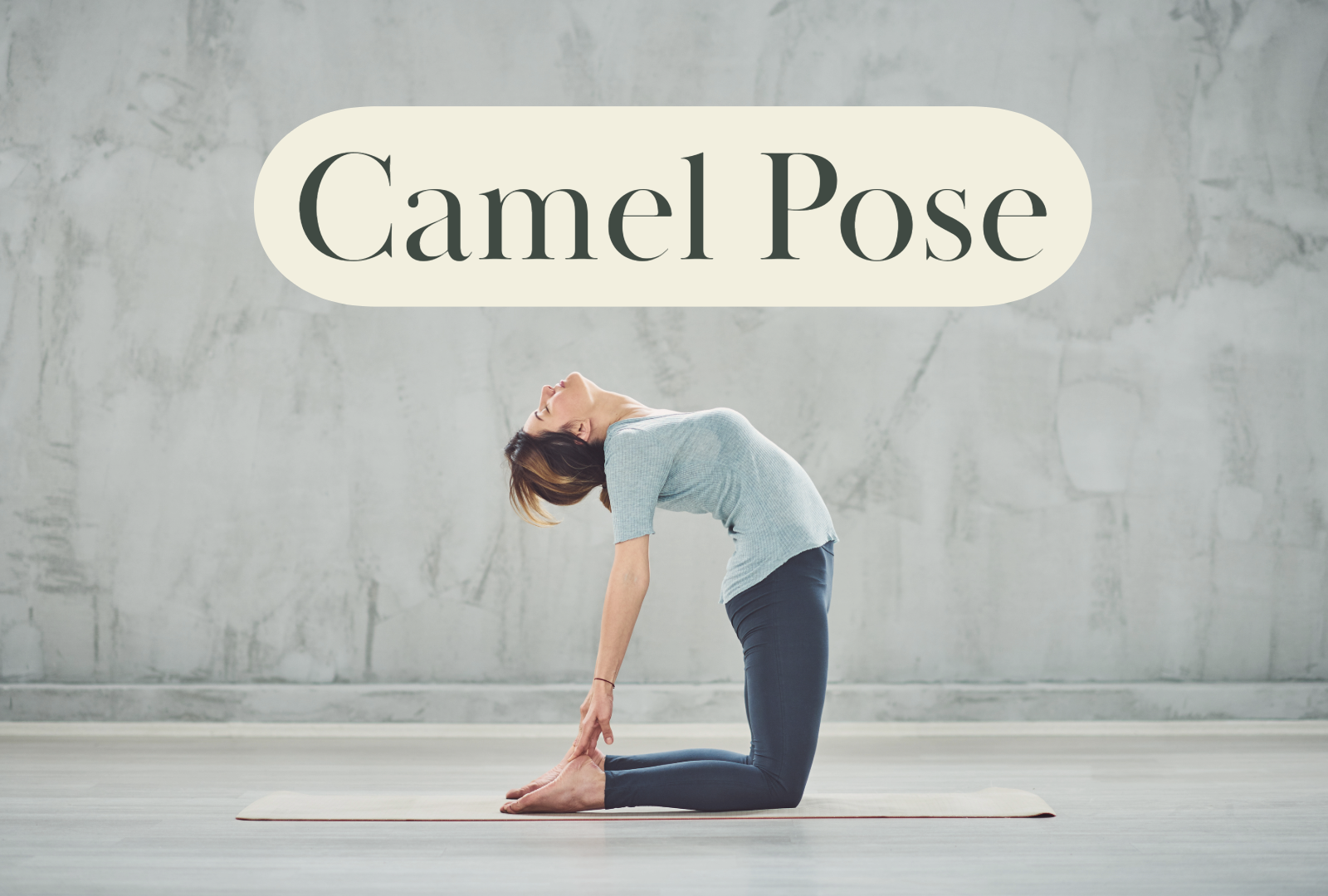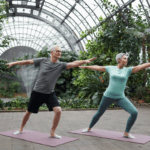Coming Soon: E-book about Kundalini Yoga - Sign up here to be among the first to get it!
Sanskrit: Ustrasana
Type: Kneeling, Back Bending Pose
Chakra Involved: Crown Chakra (Sahasrara Chakra), Third Eye Chakra (Ajna Chakra), Throat Chakra (Vishuddha Chakra), Heart Chakra (Anahata Chakra), Solar Plexus (Manipura Chakra)
Camel Pose (Ustrasana)
Camel Pose, or Ustrasana, is a heart-opening backbend that stretches the entire front of the body, from the thighs and abdominal muscles to the chest and throat, and even into the deep hip flexors. It strengthens the back muscles and improves posture by counteracting the effects of prolonged sitting and computer work. This pose is known for its potential to increase energy and relieve fatigue by opening up the chest, improving breathing capacity.
Starting Position
Begin by kneeling on the floor or a yoga mat, with your knees hip-width apart and your thighs perpendicular to the floor. Place your hands on your hips, fingers pointing downward, and ensure your shoulders are directly over your hips.
Step-by-step Instruction
- Prepare Your Foundation: Press your shins and the tops of your feet firmly into the floor. Engage your thighs to prevent them from splaying outward, and keep your hips aligned over your knees.
- Initiate the Backbend: Inhale and lengthen your spine. As you exhale, slowly begin to lean back, keeping your hands on your hips as you start to open your chest upward towards the ceiling.
- Hand Placement: When you feel a significant stretch in the front of your body, reach your hands back one at a time to grasp your heels. If you cannot comfortably reach your heels, tuck your toes to elevate your heels or use blocks placed outside of each foot.
- Deepen the Pose: With your hands securely on your heels, press your hips forward to ensure they stay over your knees. Allow your head to drop back, opening your throat, only if it feels comfortable for your neck.
- Hold the Pose: Maintain the pose for 30 seconds to a minute, breathing deeply. Focus on maintaining a steady, even breath, allowing the stretch to intensify with each exhale.
To Release the Pose
- Return to Starting Position: To come out of the pose, bring your hands back to your hips, palms supporting your lower back. Inhale as you slowly straighten the torso, leading with your heart, and lift your head last.
- Rest: Once upright, sit back on your heels and rest in Child’s Pose (Balasana) for a few breaths to neutralize your spine.
Teacher’s Tip
- Support and Alignment: Encourage students to keep their thighs perpendicular to the floor throughout the pose to protect the lower back. Using props such as blocks beside each foot can make the pose more accessible and comfortable for beginners or those with less flexibility.
- Breath and Movement: Emphasize the importance of synchronizing movement with breath. Instruct students to inhale when lengthening or lifting and to exhale when deepening the backbend or releasing into the pose.
- Neck Safety: Advise students to only drop their head back if it does not cause strain in the neck. Otherwise, recommend keeping the chin slightly tucked towards the chest to maintain alignment and protect the cervical spine.
- Modifications: For those who find it challenging to reach their heels, suggest placing hands on the lower back or sacrum for support, focusing on opening the chest and lengthening the spine rather than achieving the full depth of the pose.
Camel Pose is a powerful heart opener that requires patience and gradual progress. Encourage students to respect their bodies’ limits and to approach the pose with mindfulness and care.
Variations of Camel Pose (Ustrasana)
Camel Pose, or Ustrasana, is a dynamic backbend that can be adapted to suit various levels of flexibility and experience. Here are some common variations along with instructions for each to explore different aspects of the pose or to make it more accessible:
1. Supported Camel Pose with Blocks
- Instructions: Place blocks at your desired height outside each heel. As you enter the pose, reach back to place your hands on the blocks instead of your heels. This variation reduces the intensity of the backbend, making it accessible for beginners or those with limited back flexibility.
2. Camel Pose with Tucked Toes
- Instructions: Instead of keeping the tops of your feet flat on the mat, tuck your toes under to elevate your heels. This reduces the distance between your hands and feet, making it easier to reach your heels without straining your back.
3. Half Camel Pose
- Instructions: Perform Camel Pose with one hand reaching for the heel and the other arm extending upwards towards the ceiling. This allows for a side stretch in addition to the backbend, focusing on opening one side of the body at a time. Repeat on both sides for balance.
4. Camel Pose with a Chair
- Instructions: Place a chair behind you, and as you lean back into the pose, reach for the seat of the chair instead of your heels. This provides significant support and reduces the depth of the backbend, suitable for those with severe back issues or beginners.
5. Advanced Camel Pose with Back Arch
- Instructions: For a more advanced variation, from the full Camel Pose, extend your arms and reach for the floor behind you, increasing the depth of the backbend. Only attempt this variation if you have significant back flexibility and strength.
6. Camel Pose with Prayer Hands
- Instructions: Enter the initial stages of Camel Pose, but instead of reaching for your heels, bring your palms together in a prayer position at your heart center, and gently lean back. This focuses on opening the chest and shoulders while maintaining a more upright position.
7. Camel Pose with Wall Support
- Instructions: Kneel facing away from a wall, with your back a few inches from it. As you lean back into Camel, press your hips forward and let your hands rest on the wall instead of reaching for your heels. Slide your hands down the wall to deepen the backbend gradually.
Implementation Tips
- Warm-Up Properly: Ensure you and your students are adequately warmed up, especially the spine, shoulders, and hips, before attempting any variation of Camel Pose.
- Use Props: Encourage the use of props such as blocks, chairs, or a wall to make the pose accessible and to ensure safety.
- Listen to Your Body: Remind students to listen to their bodies and choose the variation that best suits their level of comfort and flexibility. Avoid pushing into pain or discomfort.
- Focus on Breath: Maintain a steady, even breath throughout the pose to help deepen into the backbend and release tension.
These variations allow practitioners to experience the benefits of Camel Pose at their level of comfort and flexibility, encouraging exploration and growth in their yoga practice.
FAQs About Camel Pose
Camel Pose (Ustrasana) offers several benefits:
- Stretches the Front of the Body: It deeply stretches the chest, abdomen, quadriceps, and hip flexors.
- Strengthens Back Muscles: Engages and strengthens the muscles of the back and shoulders, improving posture.
- Improves Spinal Flexibility: Enhances the flexibility of the spine, contributing to its health and vitality.
- Stimulates Abdominal Organs: The pose stimulates the abdominal organs, potentially improving digestion.
- Opens the Heart Chakra: It’s known for opening the heart chakra, which can help in releasing emotional blockages and improving emotional well-being.
Camel Pose can be challenging due to:
- Intensity of the Stretch: It requires a significant stretch in the front of the body, which can be intense for many people, especially those with tight hip flexors or shoulders.
- Backbend Depth: Achieving a deep backbend while maintaining balance and alignment requires strength, flexibility, and control.
- Breathing: Maintaining deep, steady breathing in a backbend can be difficult but is crucial for holding the pose.
- Start Kneeling: Kneel on the floor with knees hip-width apart and thighs perpendicular to the floor. Place your hands on your lower back for support.
- Hips Forward: Gently push your hips forward, keeping them above your knees.
- Lean Back: Slowly lean back, keeping your hands on your lower back or reaching them towards your heels. If you cannot reach your heels, tuck your toes to elevate them.
- Maintain the Pose: Hold the pose for a few breaths, keeping your chest lifted and shoulders back.
- Come Out Slowly: To release, bring your hands back to your lower back and slowly come up, leading with your heart.
Camel Pose is known to be emotional for some because:
- Heart Opening: It opens up the heart chakra, which is associated with emotional release, vulnerability, and letting go of suppressed emotions.
- Intense Stretch: The intensity of the physical stretch can trigger emotional responses, as the body releases tension held in the muscles.
While beneficial, Camel Pose can have disadvantages if not performed correctly:
- Strain on the Lower Back: Without proper engagement of the core and thighs, it can strain the lower back.
- Neck Discomfort: Dropping the head back too far can strain the neck.
- Risk of Dizziness: The backward bend and head position can cause dizziness or disorientation in some people.
Certain individuals should avoid or modify Camel Pose:
- People with Low Back Pain: Those with chronic or severe lower back issues should proceed with caution or avoid the pose.
- Neck Injuries: Individuals with neck injuries should keep their neck neutral and not drop the head back.
- High Blood Pressure: Those with uncontrolled high blood pressure should avoid intense backbends.
- Pregnant Women: As pregnancy progresses, deep backbends can become uncomfortable or risky.
Approaching Camel Pose with mindfulness, respecting your body’s limitations, and making modifications as necessary can help maximize its benefits while minimizing risks.




